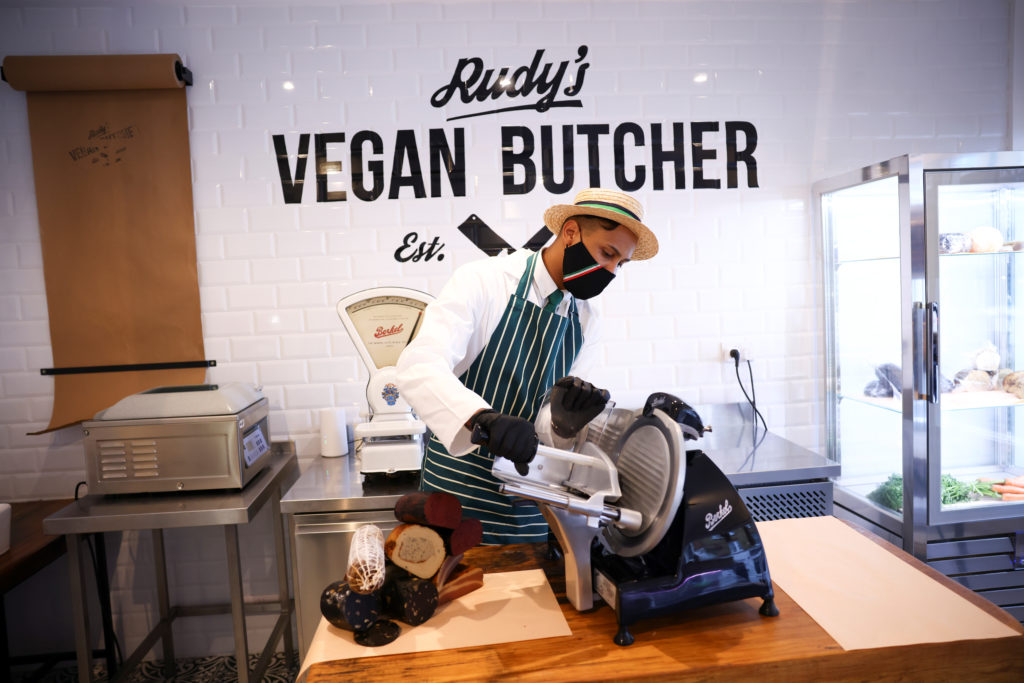 A member of staff works inside ‘Rudy’s Vegan Butcher’ shop, amid the coronavirus (COVID-19) outbreak, in London, Britain, October 30, 2020. Picture taken October 30, 2020. REUTERS/Henry Nicholls
A member of staff works inside ‘Rudy’s Vegan Butcher’ shop, amid the coronavirus (COVID-19) outbreak, in London, Britain, October 30, 2020. Picture taken October 30, 2020. REUTERS/Henry Nicholls
Aleksandra Shai Chai needed a moment to process the idea that she would be stuck eating a vegan diet for eight weeks.
Shai Chai, who typically eats meat, was participating in a study to examine the effects of different diets on twins’ health. When Stanford University researchers randomly distributed slips of papers to the twins last year to indicate which diet they would follow, Shai Chai hoped hers would say “omnivore.”
Instead, it said “vegan.” Her twin sister, Mariya Foster, would eat a diet of meat and vegetables.
Shai Chai replaced her favorite foods – bacon, sushi and steak – with tofu, beans and vegetables. She didn’t love the diet, but when Shai Chai recently learned the study’s results, she felt thankful that she had briefly changed her eating habits.
After examining 22 pairs of identical twins, researchers found that vegan eaters had lower cholesterol, insulin and body weight than participants who followed a meat diet, according to the results published last week in the JAMA Network Open journal.
Vegan eaters’ low-density lipoprotein – bad cholesterol – dropped on average by 15.2 milligrams over eight weeks; omnivore dieters’ fell by 2.4. Vegan eaters on average shed 4.2 more pounds than omnivores, and their insulin – which regulates blood sugar – dropped by roughly 20 percent more.
“That made it all worth it, for sure,” Shai Chai, 43, told The Washington Post. “I was like, ‘All right, at least I have a little bit of payback; a little benefit for the trouble.”
Christopher Gardner, a Stanford University professor of medicine, said participants’ genetics have sometimes muddied researchers’ understanding of how different diets affect people’s health. He wanted to find a clear answer on the effects of eating or avoiding meat and animal products on cardiovascular health, and he thought the best subjects would be people with nearly identical genes and upbringings.
Near the start of 2022, Gardner found participants through Stanford’s twin research registry. Shai Chai and Foster had signed up a few years earlier, thinking the studies would be a fun way to contribute to scientific discoveries. They were exactly the type of twins Gardner was looking for.
Foster was born about five minutes before Shai Chai in December of 1979 in Kyiv before they immigrated to San Francisco in 1995. They like the same food (fish and chicken), the same music (pop and techno) and sometimes unknowingly buy the same clothes. The sisters, who are 5-foot-5 and live a few blocks from each other, said they often finish each other’s sentences and know what the other is thinking.
In May of 2022, participants in the study received 21 weekly prepackaged meals from Trifecta, a meal-delivery service, featuring food from their assigned diets. The vegan meals consisted of oatmeal, tofu, broccoli, spinach, beans, lentils and brown rice. The omnivore meals were still healthy, but featured eggs, chicken, turkey bacon, vegetables and jasmine rice. Participants logged their meals on Cronometer, an app that tracks diet and health data.
Shai Chai said the vegan meals were tastier than she had expected, though she disliked some dishes. Foster sacrificed her favorite snacks – M&Ms and granola bars – for healthy meats and fruits. After seeing examples of meals following their diets, participants purchased their own groceries during the second half of the eight-week study.
Dietitians called participants a few times to discuss how they were faring. Participants also gave blood and stool samples and underwent physical and cognitive tests to assess how the diets affected their balance and memories.
Shai Chai said that after four weeks of a vegan diet, she had more energy and slept better. Still, she missed her favorite foods. Once, she went out to a sushi restaurant with friends but forced herself to eat vegan sushi.
While some participants continued to follow a vegan diet after the study concluded in July 2022, Shai Chai said she immediately started eating sushi again – which she said tasted better than ever. Foster said she has become more mindful of eating healthy and has developed meal ideas from Trifecta.
Gardner, who’s a vegetarian, hopes nutritionists use the study’s results to persuade clients to eat more vegan products. He said that vegan food contributes to the three most crucial ways to improve cardiovascular health: by increasing fiber and decreasing saturated fat and body weight.


